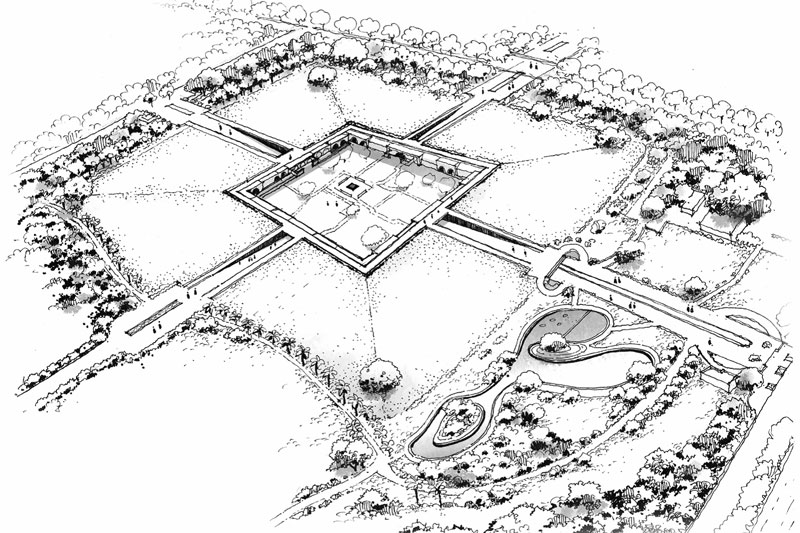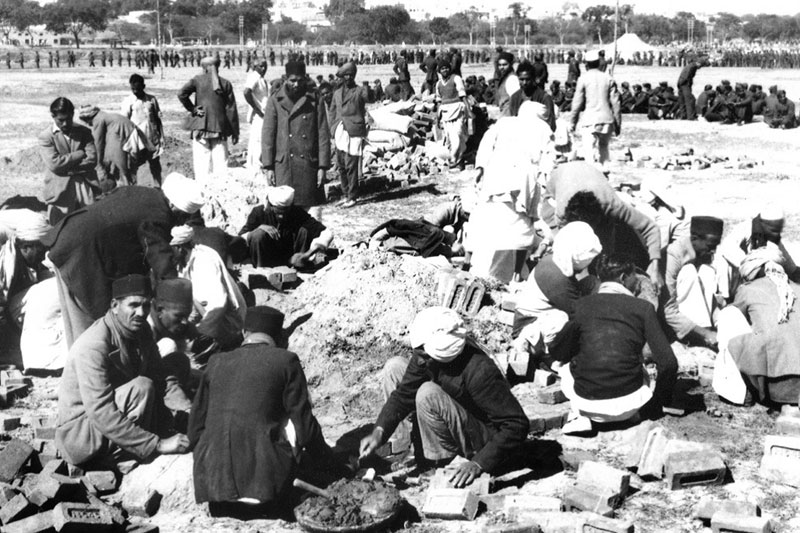Design
When Landscape Became King | Venugopal Maddipati
LA 53 |
|
| A look into how Rajghat was once much more than the place of cremation of Mohandas Karamchand Gandhi and its significance in the strife over sovereignty in Post-Independence Delhi. Under the many layers of Gandhi's memories, one discovers the site is more than what meets the eye. |
|
 |
|
The site of Rajghat, or the king's bank by the Yamuna river, is only too well-known, in the present, as the place of the cremation, in 1948, of the Indian political leader and non-violent revolutionary, Mohandas Karamchand Gandhi.
But it was not always that way. With a little bit of curiosity and imagination, one can vault past the more immediate, settled contours of the Gandhian history of Rajghat, and convey oneself into the presence of a far more antiquated landscape. One only has to leaf through the pages of Dastan-e-Ghadar: the poet ZahirDehlvi's eyewitness account of the events of 1857 in Delhi, to learn that the moniker Rajghat is an old one.
In Dehli's remembrances, a bathing ghatwas once emplaced adjacent to the RajghatDarwazawhich was one of the many gates of the Mughal city of Shahjahanabad, closer to the southern flank of the Red Fort.2 It is here, in 1857, at the bathing ghat by the RajghatDarwaza, at a short distance from what is today known as the Sunehri Masjid, that baghisawar, or rebel cavalrymen, had marched into the then British-requisitioned city of Shahjahanabad.
Walking north-west, as the crow flies, from what is presently Gandhi's memorial at Rajghat, towards the area closer to Sunehri Masjid and also closer to what is today known as the GhumshudaTalash Kendra, NayiKotwali, Daryaganj, one is apt to find oneself in the thick of place-markers that may have once hearkened, in the memories of individual witnesses, to a revolution against the authority of the British East India Company. In short, beneath the soft skin of a more recent Gandhian history at Rajghat, there may well lurk deeper veins of memory related to the strife over sovereignty in the nineteenth century. One merely has to wander away from Rajghat in the general direction of the city of Shahjahanabad, and seek more discerningly for these deep veins of memory...
|
|


|
|

|
|
|
|
| CURRENT ISSUE: LA-61 |
|
|
|
|
environment, ecology and biodiversity |
RESCUING THE URBAN POLLINATORS
MADHURA KHADE
WETLANDS AT WORK
UNDERSTANDING WETLANDS
With inputs from Dr. C. R. Babu
CONSTRUCTED WETLAND AT RAJOKRI, NEW DELHI
[Delhi Jal Board]
Ankit Srivastava
CONSTRUCTED WETLAND AT NEELA HAUZ, NEW DELHI
Landscape and Environment Planning Department,
Delhi Development Authority
CONSTRUCTED WETLAND AT HAUZ KHAS LAKE, NEW DELHI
Tarun Nanda, Evolve Engineering
RESTORATION AND REJUVENATION OF RIVER YAMUNA FLOODPLAINS, NEW DELHI
Landscape and Environment Planning Department,
Delhi Development Authority
REIMAGINING THE CITY
YAMUNA RIVER PROJECT:NEW DELHI URBAN ECOLOGY
[Authors Inaki Alday and Pankaj Vir Gupta]
Review by Geeta Wahi Dua
REJUVENATION AND RESTORATION OF URBAN PONDS, GURUGRAM
Future Institute
SPURRING ECONOMIC REVIVAL THROUGH ECOLOGICAL RESTORATION,
NANHU, CHINA
Uma Sekar
heritage, urban design, landscape architecture |
FROM MY HOUSE TO YOUR HOUSE
In conversation with Miki Desai
CITY MAPS: MAPPING NATURE AND ENVIRONMENT
Review by Rabindra J. Vasavada
A SENSE OF SPACE
Anuraag Chowfla
IN CONVERSATION WITH RANJIT SABIKHI
DEMOCRACY, PARTICIPATION AND CONSULTATION
In conversation with Bimal Patel
city and culture |
OUR CITIES CAN FIGHT COVID-19 PROACTIVELY
Mriganka Saxena and Puneet Khanna
LOCALIZING FUTURES
Geeta Wahi Dua
BOURGEOIS ENVIRONMENTALISM AND THE VULNERABILITY OF THE POOR
UNCIVIL CITY: ECOLOGY, EQUITY AND THE COMMONS IN DELHI [Author: Amita Baviskar]
Review by Nikhil Dhar
STREETSCAPES IN PUNE
CREATING A HEALTHY AND WALKABLE NEIGHBORHOOD: AUNDH NEIGHBORHOOD UPGRADATION | PUNE
Prasanna Desai Architects
ABOUT RETAIL, TREES AND YOUNG VIBES:
JANGLI MAHARAJ ROAD | PUNE
Oasis Designs Inc.
EMERGENCE OF THE EPHEMERAL
Bijoy Ramachandran
seeing the unseen |
ART FOR ALL
St+Art India Foundation
|
|